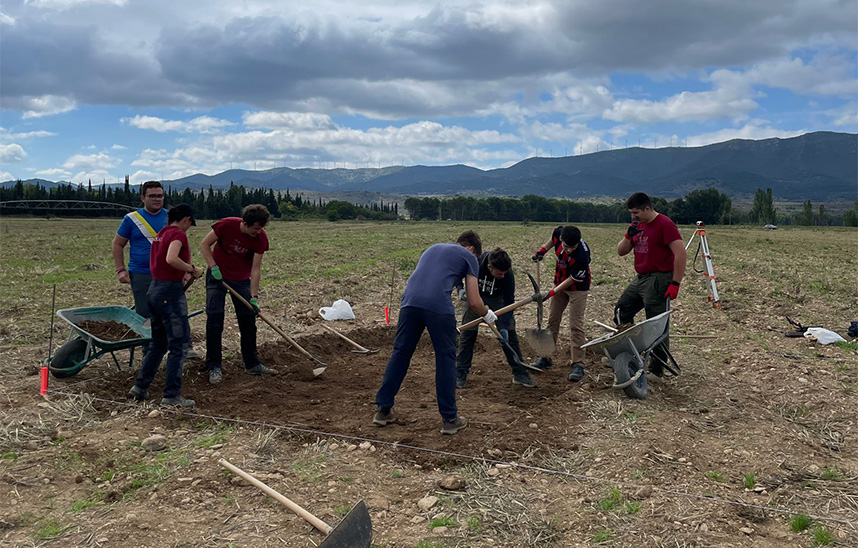End of the archaeological survey campaign at the Fillera site with the participation of University students
The intervention in the enclave, located between Sos del Rey Católico and Sangüesa, has unraveled a space of possible viticultural use.

After three weeks, the drilling campaign at the Campo Real-Fillera site, a Roman enclave located between Sos del Rey Católico and Sangüesa, has concluded. The work, carried out by a team of archaeologists with the participation of students from the University of Navarra, suggests the use of this area as a wine production site.
The project, financed by the Ministry of Science and Innovationbegan in 2023 under the direction of Javier Andreu, Full Professor of Ancient History at the University and researcher principal of project, with the participation of students of Diploma in Archaeology of the School of Philosophy and Letters. The work has also counted with the partnership of the archaeologist Luka García de la Barrera, graduate in History and Archaeology from the University and predoctoral fellow of the Government of Navarra.
During the excavations, the team has focused its efforts on the research of a structure perforated by a series of quadrangular holes, whose specific use is still unknown, although, as Professor Andreu pointed out, "it could point to a large enclosure for the installation of vines, a plantation framework ". Likewise, fragments of Roman pottery have been found in the square holes excavated in the gravel of the terrain, which could shed light on the agricultural use of area. "The findings suggest that the structure is not a simple storeroom for food, as had been initially assumed from the data aerial photography, but something completely different," explains Professor Andreu.
Although it has not yet been possible to determine the exact function of this space, its possible use as a wine production site opens new lines of research for future campaigns. "It is very satisfying to have carried out this first campaign in Fillera with our students, thus closing the cycle initiated by Alejandro Marcos and Amparo Castiella in the 1970s."
Site discovered in 1974
Professors Marcos and Castiella, then professors at the University of Navarra, discovered this site in 1974 thanks to aerial photographs; a finding that they later documented in their work "Prospecciones arqueológicas en Navarra" (Archaeological Prospecting in Navarra). In 2011, geomagnetic surveys commissioned to the University of Hamburg identified this structure, which could be part of a productive building, linked to the Economics of the small Roman cities in the Basque territory, as explained by Professor Andreu.
The Fillera site, which covers about 13 hectares, is located in a strategic point of the Roman road network that existed between Caesar Augusta (present-day Zaragoza) and Pompelo (present-day Pamplona) and just 20 kilometers from important Roman cities in the Basque Country, such as Iluberis (Lumbier), Santa Criz de Eslava or El Forau de la Tuta, in Artieda de Aragón. "Although its state of preservation is limited, the site offers valuable information on urban planning and economic life in the Roman cities of northern Hispania".
This archaeological intervention is the first of a scientific nature at the site and marks an important milestone in the study of Roman heritage in the Cinco Villas region. In 2024, the team intends to continue with the research, with the goal to unravel more details about the way of life in this Roman city.




